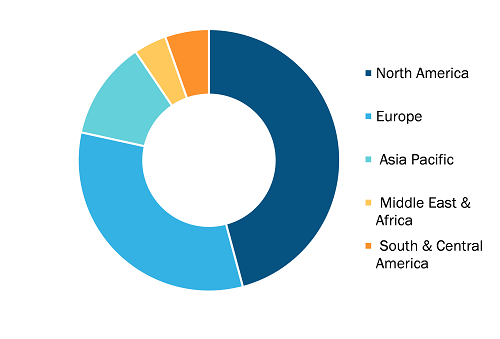According to our new research study on “Small Cell Lung Cancer (SCLC) Treatment Market Forecast to 2030 – Global Analysis – by Treatment, Stage, and End User,” the small cell lung cancer treatment market size was valued at US$ 4,480.85 million in 2022 and is expected to reach US$ 9,173.60 million by 2030; the market is estimated to register a CAGR of 9.4% from 2022 to 2030. Key factors driving the growth of the small cell lung cancer treatment market include product launches, and fast product approvals are also key factors responsible for providing lucrative market opportunities during 2020–2030.
Rising Prevalence of SCLC and Availability of Therapeutics
According to the Genentech, Inc. 2023 report, SCLC accounts for approximately 13% of all lung cancer cases with difficulty treating. Therefore, SCLC is the most aggressive type of lung cancer, with a 5-year survival rate. Current therapeutic options for SCLC are limited, and there is an unmet need for novel, effective treatments to improve survival. For example, first-line platinum-based chemotherapy (CT) is a mainstay recommended for the treatment. Also, combination chemotherapy drugs such as "Cisplastin" and" Carboplastin" are the most recommended drugs to use in combination with "Etoposide" to treat SCLC.
Small Cell Lung Cancer (SCLC) Treatment Market, by Region, 2022(%)
Small Cell Lung Cancer (SCLC) Treatment Market Size and Forecasts (2020 - 2030), Global and Regional Share, Trends, and Growth Opportunity Analysis Report Coverage: By Treatment (Chemotherapy, Radiation Therapy, Immunotherapy, and Others), Stage (Limited Stage and Extensive Stage), End User (Hospitals, Specialty Clinics, Homecare Settings, and Others), and Geography (North America, Europe, Asia Pacific, Middle East & Africa, and South & Central America)
Small Cell Lung Cancer (SCLC) Treatment Market Overview 2030
Download Free Sample
Source: The Insight Partners Analysis
The National Cancer Institute report reveals that SCLC accounts for ~15% of bronchogenic carcinomas. However, the overall incidence of SCLC in the US has decreased during the past few decades as patients have responded well to chemoradiation. For example, thoracic radiation also improved long-term healthcare outcomes for the patients. Therefore, the rising prevalence of SCLC among the population and the availability of specific therapeutics for the treatment are standalone factors responsible for the influential growth of the global SCLC market for the forecast period 2020–2030.
Based on treatment, the SCLC treatment market is segmented into chemotherapy, radiation therapy, immunotherapy, and others. In 2022, the chemotherapy segment held the largest share of the market. Small-cell lung cancer tends to respond well to chemotherapy initially. The chemotherapy drugs for SCLC are usually given through a vein as an intravenous (IV) infusion. Two of the more common chemotherapy drugs for SCLC include "Etoposide Plus Cisplatin" and "Etoposide Plus carboplatin." Additionally, "Topotecan and Lurbinectedin" are chemo drugs that can be taken by patients suffering from SCLC. Therefore, the availability of chemotherapy drugs in combination with the treatment of SCLC is responsible for influential segment growth during 2020–2030.
Based on end users, the SCLC treatment market is segmented into hospitals, specialty clinics, homecare settings, and others. In 2022, the hospitals segment held the largest share of the market. However, the specialty clinics segment is expected to register the fastest CAGR during 2022–2030. The SCLC treatment is majorly provided in hospitals as a team of pulmonologists, medical oncologists, radiation oncologists, and thoracic surgeons work closely and create a customized treatment plan for SCLC. The treatment plan includes chemotherapy, radiation therapy, and surgery. Also, hospitals provide multidisciplinary treatments for SCLC and a full range of medical conditions. In addition, various support services are provided to improve patients' quality of life and comprehensive and compassionate care. These comprehensive services include pulmonary rehabilitation, smoking cessation, psychological & social support, and integrative therapies. The NYU Langone Hospital is one such example of SCLC therapies. Therefore, customized treatment plans and support services offered by the hospitals are the major factors responsible for influential segment growth during 2020–2030.
F. Hoffmann-La Roche, Bristol Myers Squibb, AstraZeneca, Jazz Pharmaceuticals plc, Merck KgaA, Dr. Reddy's Laboratories, Inc., GlaxoSmithKline (GSK), Pfizer, Regeneron, and Janssen are among the leading companies operating in the small cell lung cancer treatment market.
The global small cell lung cancers market is segmented as treatment, stage, and end user. The global SCLC treatment market is segmented into treatment, stage, and end user. Based on treatment, the market is categorized into chemotherapy, radiation therapy, immunotherapy, and others. In terms of stages, the SCLC treatment market is bifurcated into extensive stage and limited stages. The SCLC treatment market, by the end user, the SCLC treatment market is segmented into hospitals, specialty clinics, home care settings, and others. The small cell lung cancers market, based on geography, is segmented into North America (the US, Canada, and Mexico), Europe (Germany, France, Italy, the UK, Spain, and the Rest of Europe), Asia Pacific (Australia, China, Japan, India, South Korea, and the Rest of Asia Pacific), the Middle East & Africa (South Africa, Saudi Arabia, the UAE, and the Rest of Middle East & Africa), and South & Central America (Brazil, Argentina, and the Rest of South & Central America).
Contact Us
Phone: +1-646-491-9876
Email Id: sales@theinsightpartners.com